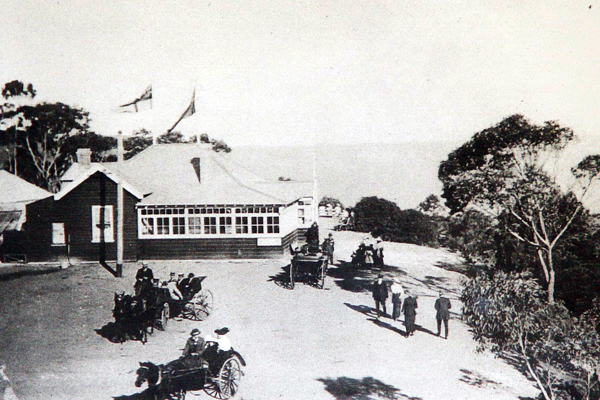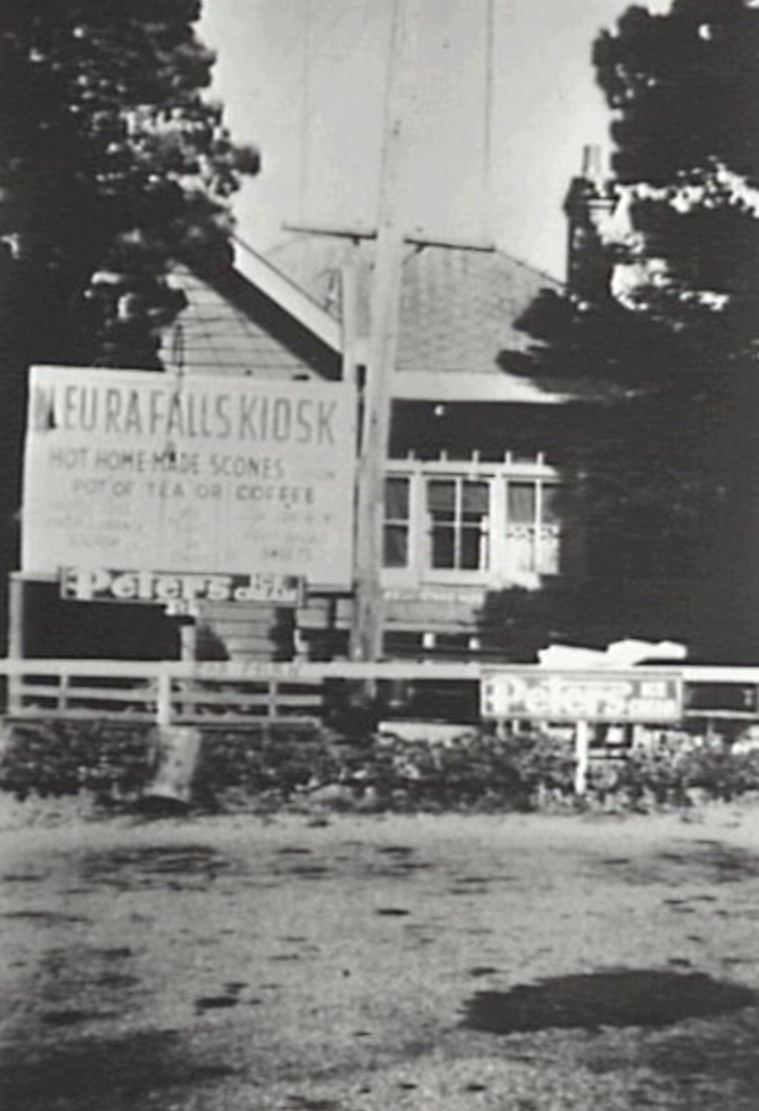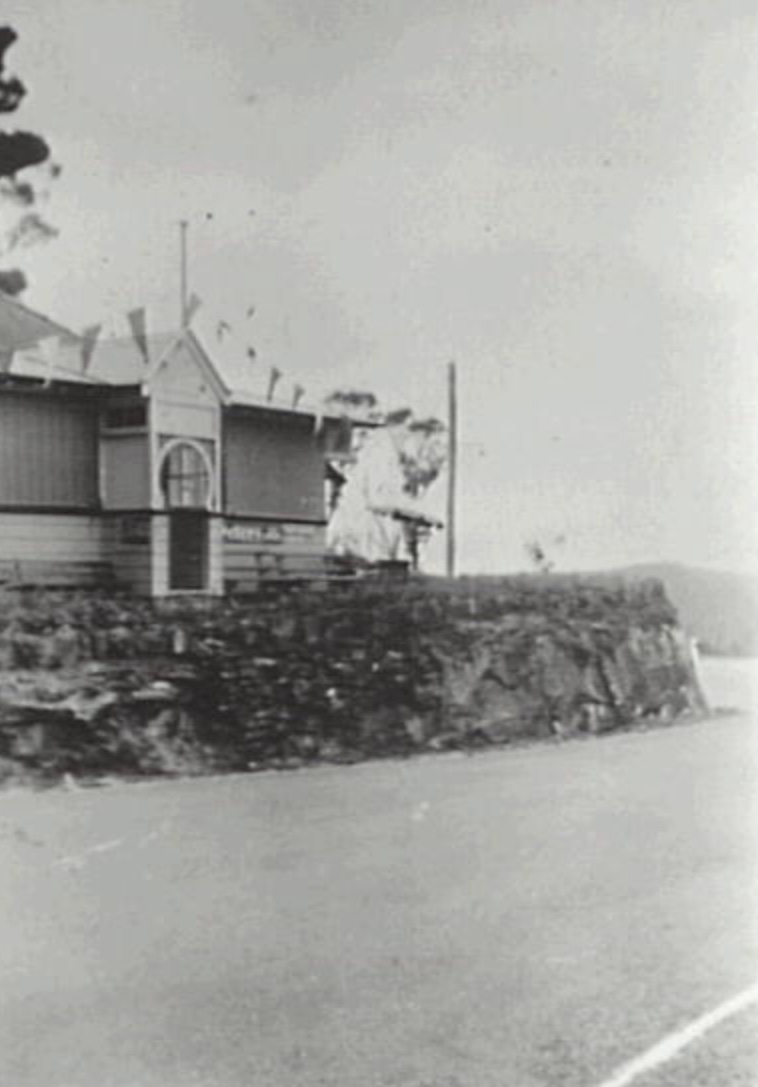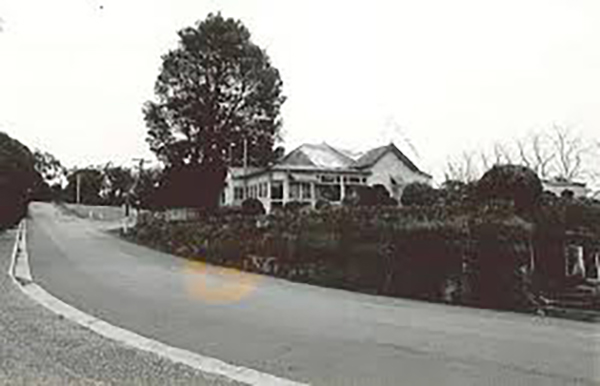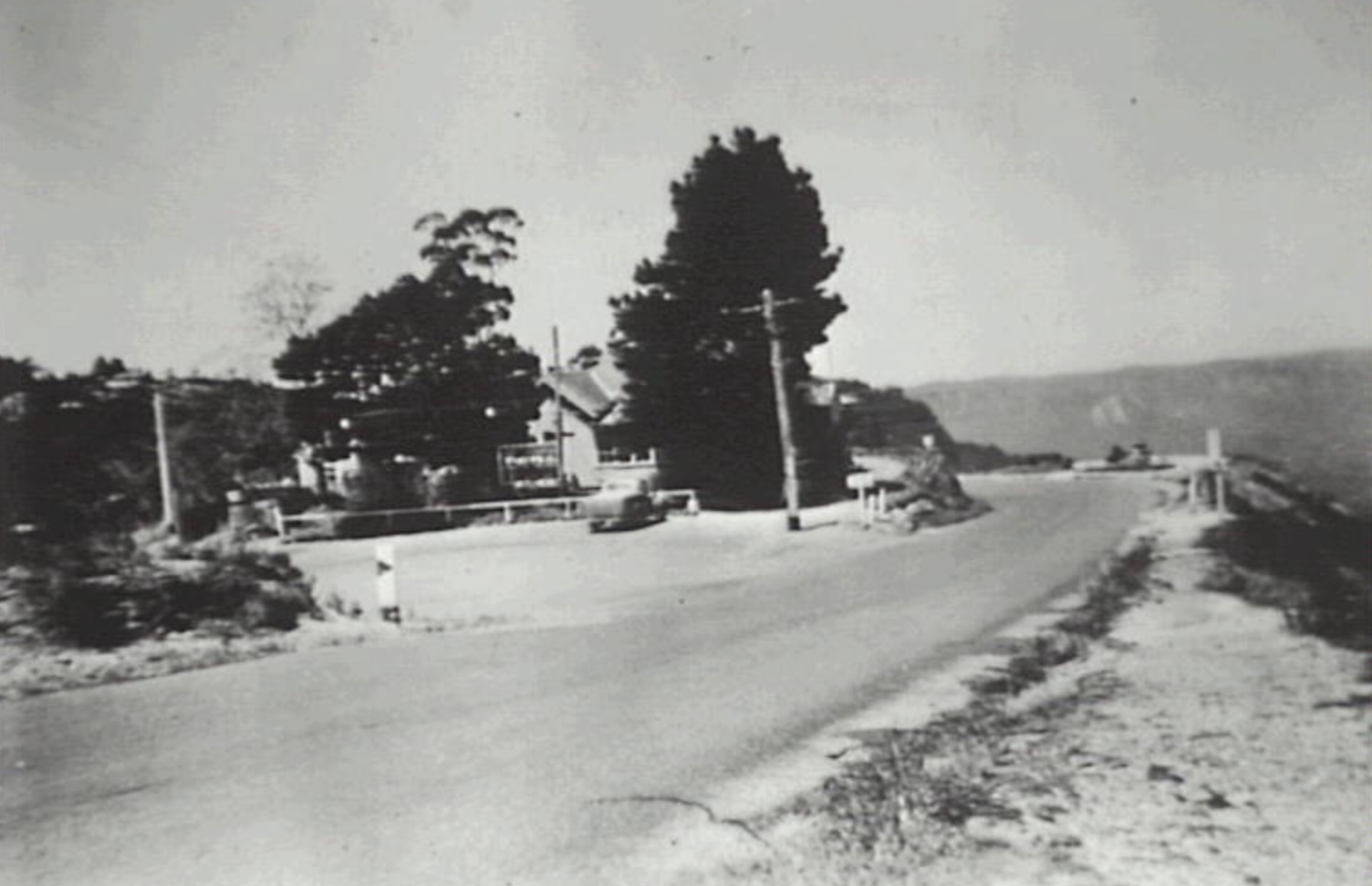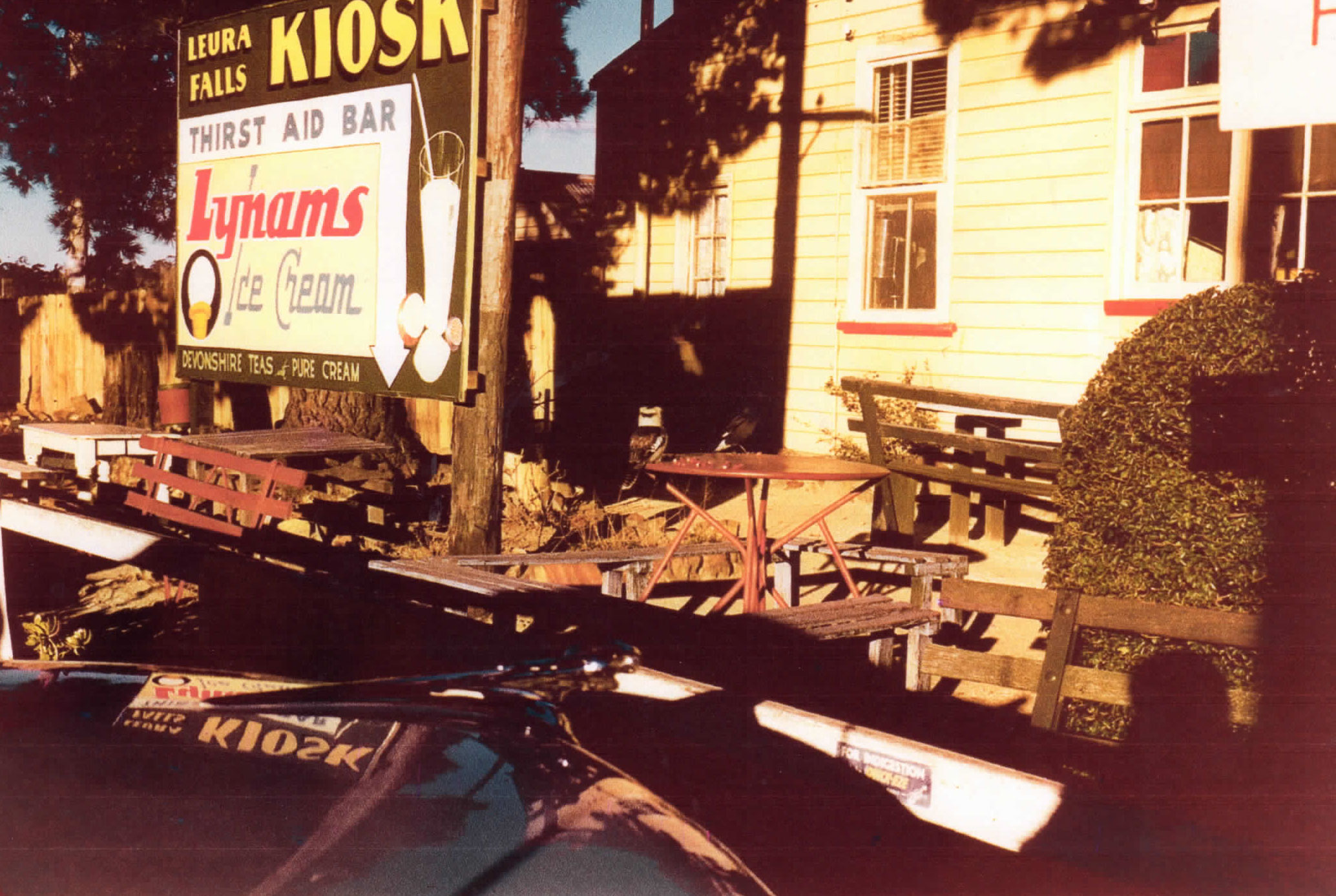The Leura Falls Kiosk
The former Kiosk is dramatically located on a hairpin bend of Cliff Drive, on a promontory, close to the edge of the escarpment between Katoomba and Leura and immediately above Leura Cascades. The strategically positioned kiosk with its garden commands significant views to the south-east. Across the road from the Kiosk is a small reserve containing a sundial on a stone pedestal giving compass bearings and distances to sites from Leura Baths Kiosk.
The Kiosk was identified in 1990 as one of four kiosks that were built throughout the upper Mountains in the early twentieth century. The BMCC heritage study in the late 1990s noted that the others were located in “Wentworth Falls, Kedumba and Leura”. The location of the other kiosk in Leura referred to at the time is not known but may have referred to the kiosk at Gordon Falls later destroyed by fire (ref Blue Mountains Echo article c1950s). It is likely now in 2016 that only the Leura Falls and Katoomba Falls kiosks remain from that original group.
The Leura Falls was amongst the earliest scenic sites to be promoted near Katoomba. In 1881 promotions of the Leura Estate subdivision identified Katoomba Falls and Leura Falls as the two key attractions (ZTP: K1/139), and by 1887 a tourist guide for the Blue Mountains was giving explicit directions on how to see the Leura Falls. (Tourists’ Guide. 1887: 12).
In the early 1900s Katoomba Municipal Council embarked on a range of improvement works linking Katoomba and Leura to encourage greater tourist access between the two towns. The work was undertaken with financial support from State Government and particularly Minister of Works at the time, Arthur Hill Griffith, who had taken the lead in 1910 under the Labour government ‘to set up state enterprises and to expand public works’ (ADB).
Although the work was locally controversial because of the cost, the outcome was widely regarded as a success for the Blue Mountains. The grant funded the construction of a road between Katoomba and Leura along the escarpment, the construction of the Leura-Katoomba Baths and Kiosk, the construction of Chelmsford Bridge and other improvements to the Cascades. The Blue Mountains Echo noted in August 1913 that “to enable Council to finance the scheme easily, Government made a present of 4000 pounds and loaned another 4000 pounds, free of interest, but which has to be refunded in easy annual payments of 300 pounds”. The article noted that “the principal advantages accruing to the alterations are a very useful pair of bathing pools, a nicely graded road from Katoomba to Leura in which some views never before enjoyed by the public have been opened, and a most graceful single-spanned monolithic bridge crossing the Leura branch of waters…it would be a wise step on the part of Council to resume the area through which the Cascades run so that their beauty might be saved to the public for all time. The new kiosk is already in course of construction and should be ready in two or three months’ time. When this is done, and the new seating installed, Leura Point will be the smartest place of vantage on the Mountains.” (BME 1/08/1913)
By 1910 the Trustees of the Leura Reserve had built refreshment rooms at Leura Falls, probably on the site of the present kiosk, and advertised them for a year’s lease in August 1910 (BME, 20/8/1910, p.9). The lease was soon extended to 10 years and early in 1913 the well-known Captain on the local fire brigade, Joseph Pannell, also an alderman, purchased the lease and announced that he was about to replace the ‘temporary rooms’ with a ‘splendid new kiosk’ (BME, 2/5/13, p.9). Two carpenters were employed in September to build the new kiosk, which was open for business in December 1913, on a new ten-year lease: at the end of the lease the property was to revert to the Council. (BME, 5/9/1913, p.5; 12 /12/1913, p.6)
The kiosk was integral to the Council’s improvement scheme, providing refreshments to visitors walking the escarpment and to those using the baths. The siting of the kiosk up the hill from the baths allowed visitors to the “Meeting of the Waters’ to also enjoy the majestic views. The official opening of the project on 5th December 1913 was widely covered by the local and regional newspapers. An article in the Blue Mountains Echo at the official opening noted “to the credit of the Katoomba Municipal Authorities, within the last few years, they have awakened to the importance of opening up additional scenic attractions in our natural wonderland to the tourist public, upon whom the prosperity of the town so largely depends”. The article also referred to the kiosk in its lengthy coverage, noting that “In addition to the Baths, Mr Pannell had spent over 500 pounds on a kiosk, which at the end of ten years would revert to Council. No interest or principal asked until the Baths were revenue producing. Payments would start now and in eleven years this beautiful asset would be paid off and be a property of the people”. The official opening of the Baths concluded “the Meeting of the Waters has gained in beauty, utility and popularity, and in years to come will prove a valuable asset to the Municipality”. (BME 5/12/1913).
The kiosk appears to have been constructed by Fire Brigade Captain J.J. Pannell who was for many years an alderman of the local Council. The article in the Blue Mountains Echo records the opening in some detail. “Opening the Kiosk : Mr J.J. Pannell’s Enterprise. At the conclusion of the opening of the Baths on Wednesday last, an adjournment was made to the new kiosk just erected by Mr J.J. Pannell at Leura’s far-famed Look-out. The proprietor very generously extended an invitation to all ladies present at the opening ceremony to partake of refreshment at the kiosk rooms and over 200 availed themselves of the opportunity. The sterner sex ‘paid their footing’ and with the presence of the Ministerial and civic party, the kiosk presented quite a gay appearance.
At the latter table, a few toasts apropos of the occasion were proposed and honoured. Hon. Arthur Griffiths in the course of a very happy speech proposed success to the Municipal Baths…Ald Goyder referred to the good work that Mr Pannell had done for the town and to the enterprise he had shown in erecting the kiosk on a ten-years occupancy lease at the termination of which period it would revert to Council…”
The kiosk provided refreshments for the swimmers and picnickers who would flock to the Leura Baths, now Leura Cascades picnic grounds. The kiosk operated as refreshment rooms run by Joseph Pannell and his wife with Joseph becoming well-known to Blue Mountains tourists as proprietor of the kiosk. Joseph sadly committed suicide in January 1915 after a nervous breakdown. Mrs Pannell continued to run the kiosk for another fourteen years, but sold the good-will and the furnishings in August 1929 and retired to Blayney where she died in 1931 (BMStar 31/8/1929 p.9, 17/1/1931, p.5).
The scenic development by Council which had started in the early 1900s continued with the construction of the Prince Henry Walk in the mid-1930s, reinforcing the escarpment link between Katoomba and Leura, the siting of the Leura Falls Kiosk, and including further improvements to the Cascades, including the novel introduction of night time lighting of the Leura Cascades walk to the Leura Falls lookout.
From around 1943 until the late 1950s the kiosk was operated by Mrs Park and her daughter Marjorie. In 1969, the restaurant changed hands and became known as the Fork n’ View. In 1990 the former Leura Falls Kiosk was identified as part of a heritage study as one of only 4 remaining kiosks (the others being located at Wentworth Falls, Katoomba Falls, and Leura) that were built in the early twentieth century during the height of the tourist boom in the Blue Mountains.
In 2000 the restaurant became known as Solitary and in 2024 the restaurant is set to recommence trading as Sequoia Restaurant under new and current management.
Majority of information above contained within Draft Heritage Form – Former Leura Baths Kiosk.
Images collected from various sources and may be subject to copyright.
If you have any historic images of the property, please share and email to andrew@sequoiabluemountains.com.au

